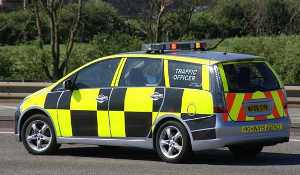What Power Do England Highways Traffic Officers Have?

Somewhat disrespectfully known as ‘Wombles’ in some quarters, Highways England Traffic Officers (HETOs) have a strong visual presence on our motorways. But most motorists would probably be hard pressed to describe their role in any detail.
Yes, they can be seen driving around vehicles with similar markings to the police vehicles. But do they have the power to issue speeding tickets? Or can they, for example, demand to see evidence that you have a valid insurance policy?
In this article we take a look at what HETOs actually do and examine what powers are granted to these officers who patrol England’s motorways.
Incident Management
Because Highways England traffic officers are often required to work alongside the regular police force, there will always be some overlap of functions. With motorway incidents, it regularly falls to these traffic officers to coordinate the efforts of the emergency services in attendance.
Accidents and breakdowns on motorways tend to also cause traffic congestion, so a large part of a traffic officer’s role will involve managing traffic to minimise the real risk of a system gridlock.
Police officers still investigate accidents where there have been serious injuries or fatalities. However, apart from the normal HETO role in avoiding traffic chaos and congestion, such incidents also tend to leave debris spread across the carriageways, and traffic officers are responsible for ensuring all such obstacles are cleared away.
Traffic Flows
Ever since 2005, HETO personnel have taken responsibility for the day-to-day running of our motorway networks. They organise the electronic messaging which informs drivers about details which may impact of their journey, and provide the information given to the public in local travel reports.
If you breakdown on the motorway, or become involved in an accident or driving incident, it may well be a HETO team that comes to your assistance and arranges to remove any damaged vehicles.
Perhaps most important of all, the HETO force are usually the ‘boots on the ground’ when it comes to setting up temporary road closures and dealing with potentially dangerous tasks such as creating an emergency rolling roadblock.
Traffic Officer Powers
You are obliged to comply with directions issued by a traffic officer – and any failure to do so will have consequences: a fine of up to £1,000, maybe accompanied by an endorsement on your driving licence, or even a potential disqualification.

The Traffic Management Act which became law in 2004 gives traffic officers the power to:
– close motorway lanes and carriageways,
– stop and redirect traffic flows,
– manage traffic.
Statutory Removal
While most legal powers may cause occasional controversy from time to time, HETO’s power to ‘require a vehicle to be moved if they believe it is blocking traffic or endangering road users’ is the one which so often enrages drivers caught up in what they may see as an unfortunate turn of events.
From HETO’s perspective, abandoned and/or broken-down vehicles create delays and cause accidents on our high-speed motorway corridors. That’s why traffic officers rarely wait too long before implementing what is known as a ‘statutory removal’ of a vehicle causing some kind of hazard situation.
It’s not always easy to avoid this sure-fire way to attract a Womble, but Highways England advice is clear: ‘If your vehicle breaks down or is damaged and requires an expert like a garage mechanic from the motor trade industry, be sure to move it to a place of relative safety as soon as it is safe to do so … Regardless whether it’s a privately owned vehicle, or on motor trade plates, if you need to leave the vehicle unattended, inform a Traffic Officer or Police Officer using the nearest emergency telephone.’
You have been warned!






